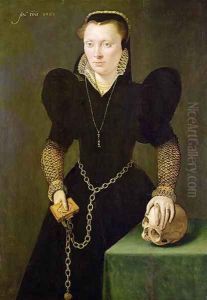Adriaen van Cronenburgh Paintings
Adriaen van Cronenburgh was a Dutch Renaissance painter whose life details are not well-documented, but he is believed to have been active during the 16th century, around the period from the late 1490s or early 1500s to the 1560s. While his exact birth year is not known, it is usually estimated around 1500. The year of his death is also uncertain, and there are no records that provide a definitive date, leading to a general characterization of his life span as the first half of the 16th century.
Cronenburgh is known for his portraits, which were quite distinctive and stylistically aligned with the Northern Renaissance. His works are characterized by their detailed representation of textures and fabrics, as well as the meticulous depiction of individual characteristics of the sitters, which was a hallmark of portrait painting during this era.
The artist's geographical origins are suggested by his surname, which indicates he might have been from the town of Cronenburg, which is now known as Kronenburg, a part of the modern-day Netherlands. However, details about his training and early career are scarce. It is believed that he may have traveled or been influenced by other regions in Europe, which was a common practice for artists during the Renaissance as they sought to learn from different masters and artistic centers.
One of his most famous works is the portrait of Jacob Omphalius, painted in 1538, which exhibits a high degree of realism and attention to detail that was a signature of his style. His paintings often include intricate backgrounds and use symbolism to convey additional meaning about the subject.
Despite the limited information on Adriaen van Cronenburgh’s life and the relatively small number of works attributed to him, his paintings are considered significant contributions to Dutch Renaissance art. They provide insight into the cultural and social contexts of the period, especially through the lens of portraiture. His works are held in various collections and continue to be studied for their art historical value.
